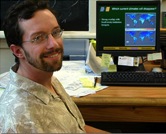Understanding the past and predicting the future by looking across space and time
Studying complex systems like ecosystems can get messy, especially when trying to predict how they interact with other big unknowns like climate change.

Jessica Blois
In a new paper published this week (May 20) in the Proceedings of the National Academy of Sciences, researchers from the University of Wisconsin–Madison and elsewhere validate a fundamental assumption at the very heart of a popular way to predict relationships between complex variables.
To model how climate changes may impact biodiversity, researchers like Jessica Blois and John W. (Jack) Williams routinely use an approach called “space-for-time substitution.” The idea behind this method is to use the information in current geographic distributions of species to build a model that can predict climate-driven ecological changes in the past or future. But does it really work?
“It’s a necessary assumption, but it’s generally untested,” says lead study author Blois, a former postdoctoral fellow with Williams at UW–Madison. She is now an assistant professor at the University of California, Merced. “Yet we’re using this every day when we make predictions about biodiversity going into the future with climate change.”
Their results should give other ecologists — and potentially others such as economists who use similar models — more confidence in their methods.

Jack Williams
“At these spatial and temporal scales, the space-for-time assumption does work well,” says Williams, professor of geography and director of the Center for Climatic Research at the UW–Madison Nelson Institute for Environmental Studies. “Our fossil data did support the idea that you can use spatial relationships as a source of information for making these predictions for the future.”
Their research focus is paleoecology, the study of ancient ecosystems. By looking at fossilized pollen trapped in cores of sediment from the bottoms of lakes, the scientists reconstructed information about the plant communities present at locations across eastern North America during the past 21,000 years.
If climate has influenced communities the same way across space and through time, Blois explains, then a model based on the spatial data should make the same predictions as a model based on their temporal data. And in fact, they did.
The space-for-time model explained about 72 percent of the variation seen in their time data, and the remainder is likely due to other biological and environmental factors that the simplified model does not include, Blois says.
Though the testing does not capture all the ways space-for-time substitutions are used in other predictive fields, she says that the results are very encouraging for questions spanning large geographic and time scales — scales at which collecting good temporal data can be very challenging.
“We found that at these broad time scales we’re looking at, that space does substitute for time relatively well,” Blois says. “It makes me more confident in my analyses going forward.”
Tags: climate change, conservation, research




